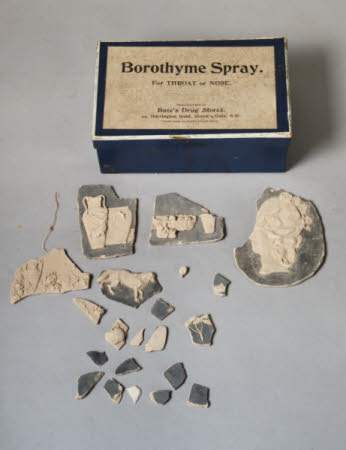Plaque
Category
Ceramics
Date
Unknown
Materials
unfired clay
Measurements
105 mm (Length)17 mm (Length)
Order this imageCollection
Hill Top, Cumbria
NT 641537
Summary
In a box, several small plaques with relief work on a grey ground; unfired; all broken, some severely; one a silhouette of a lady, one with vases and fruit-basket, one with a dog; the silhouette possibly signed 'BP' (monogram), 'X 4', 'Xmas Eve'; a fragment with vases possibly signed 'BP' (monogram), 'X5'; the box marked 'Borothyme Spray'.
Full description
This box of unfired clay fragments is part of the collection at Hill Top. Beatrix Potter purchased this farmhouse in the Lake District village of Near Sawrey in 1905, using the profits from her books. After her marriage to William Heelis in 1913, Beatrix relocated permanently to Sawrey. The couple made nearby Castle Cottage their home, but Beatrix spent as much time as she could at Hill Top. As well as a space for work and creativity – and the location for many of her famous tales – it became an intensely personal sanctuary for Beatrix. Beatrix knew exactly how she would decorate Hill Top and arranged its interiors carefully and deliberately. She wrote: ‘I would have old furniture…it is not as expensive as modern furniture, and incomparably handsomer…’ Once she had renovated the farmhouse, she filled it with examples of local furniture and treasured heirlooms, like her grandmother’s warming pan and a set of plates decorated with designs by her father. Beatrix had a lifelong passion for pottery – and particularly for Wedgwood. In December 1879, she sketched a Wedgwood vase owned by her parents (V&A LC 1/B/1) that is now in the collection at Hill Top (NT641467). In addition to decorating and drawing ceramics, Beatrix also experimented directly with clay. In 1884 she found some white clay on holiday and brought it home to make cameos and plaques in the style of Wedgwood, adding a blue colour in imitation of jasperware. This small box of damaged pieces at Hill Top might be some of these pieces. They are made from partly blue-stained, unfired clay and a couple have Beatrix’s monogram on the reverse. Beatrix described at the time an ‘irresistible desire to copy any beautiful object which strikes the eye. Why cannot one be content to look at it? I cannot rest, I must draw…’ A few months later Beatrix recounts in her diary going to an exhibition at Devonshire House in Belgrave Square and is quite clear about what she liked and didn’t, describing ‘a good deal of priceless and hideous Sèvres, Chelsea and Dresden, and about a dozen most lovely and perfect pieces of Wedgwood. I think I never saw more delicate and transparent Wedgwood than some of the cameos.’ This interest in pottery stayed with Beatrix throughout her life – she would even come to own a prize-winning Herdwick sheep named Saddleback Wedgewood [sic].
References
Conroy 2023: Rachel Conroy, ‘A love of ‘old china, especially earthenware’: ceramics at Beatrix Potter’s Hill Top and in her ‘little books’, Transactions of the English Ceramic Circle (Volume 34, 2023), 95-112
